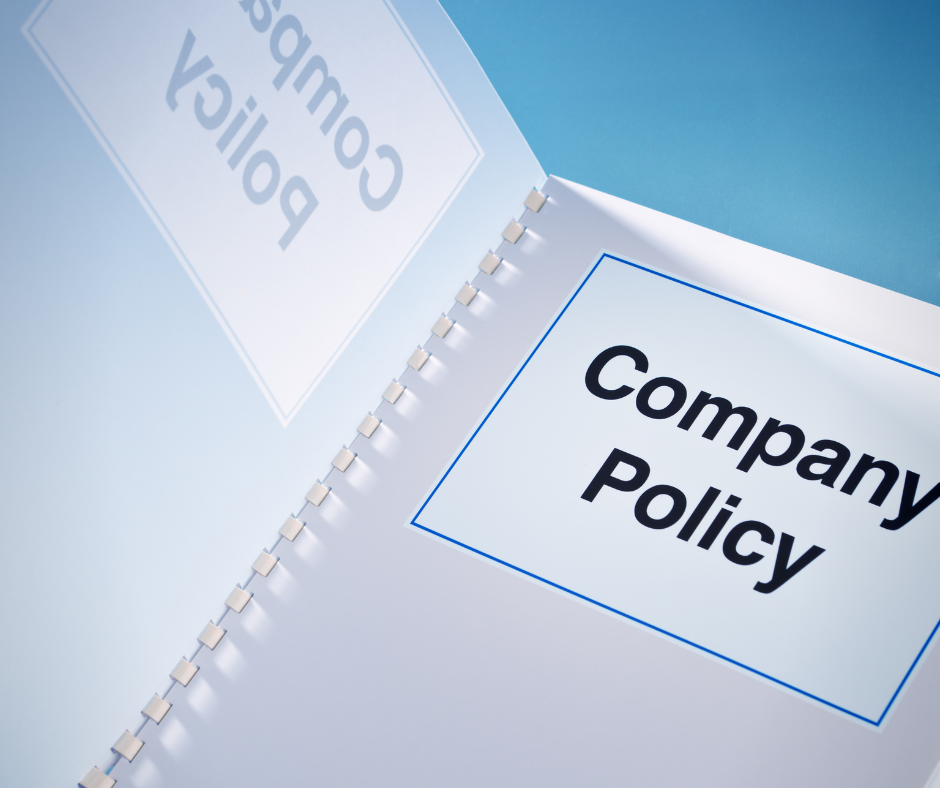
Key takeaway:
- Employee handbooks are crucial for Fabricated Metal Product Manufacturing companies: It outlines the workplace policies, employee benefits, safety procedures, and the code of conduct and ethics. A well-crafted handbook helps employees to understand their rights and responsibilities and promotes a healthy work environment.
- Developing and implementing employee handbooks should follow necessary steps, such as identifying the key topics, drafting the content, reviewing and revising the content, and communicating and training employees. This not only ensures legal compliance but also promotes consistency in the workplace.
- Maintaining and updating employee handbooks is equally important: Regular reviews and updates help the company stay in compliance with the latest laws and regulations, and updates should be communicated to employees as soon as possible. This helps to promote transparency and reduce misunderstandings, ensuring a healthy work environment.
Are you a business in the Fabricated Metal Products Manufacturing industry struggling with employee handbooks? This blog will explain how to create helpful and organized handbooks for your business. You’ll discover the essential information to include and the powerful benefits of a well-crafted employee handbook.

Overview of Employee Handbooks in the Fabricated Metal Product Manufacturing Industry
In Fabricated Metal Product Manufacturing companies, employee handbooks play a crucial role in conveying policies, benefits, and expectations to new and existing employees. These handbooks act as a reference guide for employees to understand the company’s goals and values, performance standards, and the path to success within the company. The handbooks are regularly updated to keep them relevant and accurate. This ensures a safe and productive work environment.
Moreover, employee handbooks for Fabricated Metal Product Manufacturing companies typically cover topics like safety, quality control, work hours, compensation, benefits, and career development. The information provided in these handbooks not only protects the company from lawsuits but also helps employees understand what is expected of them. This leads to greater job satisfaction and retention, which in turn results in a more efficient work environment.
Some unique details to be aware of in such employee handbooks are the specific details surrounding safety regulations, given the potential safety hazards of working in Fabricated Metal Product Manufacturing. Another important consideration is addressing the use of heavy machinery and equipment in training manuals. Additionally, policies pertaining to environmental regulations and sustainability initiatives of the company may be included.
To maximize the effectiveness of the employee handbook, the company should encourage employees to read it in its entirety and make it easily accessible, either in print or digital formats. The tone of the handbook should make it clear that it is a valuable resource that helps create a unified team. The company can also schedule training sessions to review changes or updates to the handbook. By doing so, employees feel valued and understood, leading to a positive work environment and more productive employees in the long run.
While different industries may differ in how they approach employee handbooks, Fabricated Metal Product Manufacturing companies need to emphasize the importance of creating clear and concise handbooks that accurately reflect their company culture, mission, and values. Through strategic planning and implementation, employee handbooks can become a valuable asset for any organization, including those in Finance and Insurance companies.
Importance of Employee Handbooks in Fabricated Metal Product Manufacturing Companies
Employee Handbooks in Fabricated Metal Product Manufacturing Companies play a crucial role in ensuring that employees understand the organizational policies, protocols, and procedures, thereby minimizing potential legal and compliance issues. These handbooks also help in establishing clear expectations, promoting a positive workplace culture, and improving employee retention. Moreover, they assist in standardizing training programs and facilitate efficient communication and dispute resolution.
By not having a well-crafted employee handbook, companies may miss out on opportunities to protect themselves from legal disputes and compliance issues. Additionally, it may lead to confusion among employees and result in productivity losses. Thus, it is imperative for Fabricated Metal Product Manufacturing companies to have an up-to-date employee handbook. Incorporating specific company policies, local and federal regulations, and other essential information in the employee handbook will facilitate a more productive workforce and help avoid costly legal issues. Companies should also regularly review and update their handbooks to stay compliant with rapidly changing laws and regulations.
To ensure that your company is not missing out on the benefits of a well-crafted employee handbook, it is essential to seek the help of experts in the field. By creating an informative and detailed handbook, companies can maximize their productivity and protect themselves from potential legal and compliance issues. Don’t let your company fall behind; act today and ensure that you have a comprehensive employee handbook in place.

Content of Employee Handbooks
Fabricated metal product manufacturing companies require a comprehensive employee handbook. Essential elements to consider are outlined company policies and procedures.
This section examines key aspects of employee handbooks, including:
- Workplace Policies
- Employee Benefits
- Safety Procedures
- Code of Conduct
- Ethics
Workplace Policies
The guidelines and regulations that define workplace conduct in Fabricated Metal Product Manufacturing companies must be summarized in a neat and concise manner. Policies such as code of ethics, safety rules and codes of conduct ought to be clarified for the workforce to adhere to routine operations. These policies should also cover employee benefits, rights, and responsibilities. Employee handbooks need to adhere to federal laws while progressively highlighting company-specific regulations designed in-house. By spelling out all affected rules, employees can focus on their jobs without anxiety over technicalities. In Fabricated Metal Product Manufacturing enterprises, complex machinery usage policies have to be mentioned in detail. Aspects like maintenance protocols, equipment usage guidelines and repair procedures ought to be conveyed through effective communication strategies.
According to the U.S Department of Labor Bureau of Labor Statistics and OSHERA-Department of Veterans Affairs, including graphics or photographs within handbooks may clarify complex drug protocols amongst workers with reading disabilities or those not fluent in English.
Working at a fabricated metal product manufacturing company might not give you superpowers, but the employee benefits are definitely worth the grind.
Employee Benefits
To understand the various advantages that employees can receive, let us explore the Perks and Privileges offered by Fabricated Metal Product Manufacturing company’s Employee Policies:
- Medical insurance coverage for employees and their dependents.
- Generous paid time off and paid holidays benefits to support employee’s work-life balance.
- Retirement plans with company matching contributions for secured future financial planning.
- Vacation time packages, flexible schedules, and remote work opportunities to ensure employee satisfaction.
- Tuition reimbursement programs covering fees for professional development courses or educational courses to encourage employee skill-development.
- Childcare facilities including on-site daycares or discounts on childcare services provided to help working parents manage their work-life balance efficiently.
It is worth noting that, besides these facilities, the company also provides various other perks related to health and wellness of its employees. These include free gym memberships, mental wellness support programs, outdoor recreational activities along with staff engagement programs fostering teamwork and employee loyalty.
One of the notable events includes how a female engineer claimed her employer discriminated against her because she was pregnant. Although the organization has outstanding policies that care about exclusive requirements during this phase of life, it tackled the controversy promptly without compromising on its core values revolving around supporting its employees’ welfare. Remember, safety always comes first…unless there’s a deadline to meet.
Safety Procedures
Fostering Safe Working Environment for Fabricated Metal Product Manufacturing Companies Employee safety is critical for larger and complex manufacturing units like fabricated metal products. Ensuring that working conditions minimize potential risks and injuries, a comprehensive guide on suitable safety procedures, such as the one provided in this article on employee handbooks for merchant wholesalers, durable goods companies, can aid in minimizing any mishaps. Here are five crucial steps to bring about a safe working environment:
- Prioritize Personal Protective Equipment (PPE) by suitably integrating it into Standard Operating Procedures (SOPs).
- Conduct regular drills/ mock activities to train employees in hazardous situations.
- Craft an emergency response plan to be executed immediately during unforeseen circumstances and train employees accordingly. If you are an information company, you may want to check out this guide on employee handbooks for more insights.
- Conduct investigations and risk assessments regularly to identify potential risks in the manufacturing unit.
- Provide exhaustive training resources, easy-to-understand recall material, and certifications of compliance.
To supplement these procedures, regular communication with the workforce on health & safety practices through employee handbooks containing not just rules but informative material is key.
In addition to the mentioned guidelines, it is also crucial to set up reliable reporting mechanisms for potential dangers or risks identified by employees’ reliability in this exercise quells concerns that may fail implementation plans.
Pro Tip: Ensuring your employees go through periodic updated training programs boosts efficiency while improving their knowledge of industrial safety. Remember, the code of conduct isn’t just a suggestion – it’s more like a legally binding suggestion.
Code of Conduct and Ethics
A set of moral principles that guide employees’ behavior in Fabricated Metal Product Manufacturing companies. It includes guidelines on professional conduct, relationships with colleagues, conflict resolution policies, and decision-making processes. A comprehensive code of ethics ensures a safe and productive working environment for all employees. It reminds employees of the values an organization holds dear and strengthens the bond between them. Companies often design their codes to align with industry standards and legal regulations. Adhering to such codes is critical for company reputation and overall growth.
According to experts at SHRM (Society for Human Resource Management), an employer should make specific language provisions about what conduct will not be tolerated in the workplace or what actions it expects from employees when they encounter unethical or improper practices.
A robust ethical framework enables companies to promote integrity and accountability among team members.
It’s like giving your employees a GPS for navigating office policies and procedures, except they’ll still manage to get lost.

Developing and Implementing Employee Handbooks
Need to create employee handbooks for metal product makers? Here’s what you do:
- Develop the handbooks.
- Explain and teach employees about the handbooks.
Steps for Developing Employee Handbooks
Developing a Handbook for Employee Policy Guidance in Fabricated Metal Product Manufacturing Companies involves several crucial steps of careful planning and implementation. To ensure coherence and consistency, a semantic NLP approach should be used to educate employees about the company’s values, policies, practices, and guidelines. The following steps can be taken in developing the handbook:
- Define Objectives: Establish expectations, roles, and responsibilities for both employers and employees in computer and electronic product manufacturing companies
- Review Related Laws: Identify governing laws related to employment terms and policies
- Tailor Content: Customize the handbook to meet the unique needs of the company and its workforce, including educational services companies.
- Create Simple & Clear Language: Employees should understand their rights and obligations with ease. If you are in the leather and allied product manufacturing industry, having clear and concise employee handbooks is crucial for maintaining a healthy and productive workforce.
- Communicate Effectively: Ensure all staff members in repair and maintenance companies receive copies of revised handbooks, policy changes are conveyed clearly.
- Regular Revision: Update materials consistently to include all changes in regulations or corporate objectives that may require modification.
It is essential to include other minor details such as instructions on how to report violations of employee policies, dispute resolution procedures, disciplinary actions for violation of company procedures, time off work rules amongst others. Pro Tip: Developing an employee handbook shouldn’t just be approached only from compliance reasons but also keeping learning preferences in mind as it contains information aimed at helping staff understand what they need to know when working within an organization. When it comes to employee handbooks, the only training some employees need is how to use them as a makeshift doorstop.
Communicating and Training Employees on Employee Handbooks
Ensuring mutual awareness of the regulations in the Employee Handbook within an organisation is crucial. To begin, it is important to impart how vital the handbook is and stress adherence to each policy. The process of presenting the handbook should include training sessions that provide clarity on expectations and consequences of not complying. These sessions should be interactive to enable employees’ participation and feedback. Equally significant is making sure every employee reads and understands the handbook. Hence, a policy on acknowledging receipt of company handbooks should become a norm during orientation or any meeting conducted at this level. Building on this regular acknowledgement could take place quarterly through departmental meetings as an added measure to ensure organizational cohesion. Check out some sample employee handbooks for general merchandise stores companies to get inspired. Moreover, actively infusing stories into scenarios that reinforce Employee Handbook principles would help imprint the significance on employees’ minds quickly. It opens up dialogue among employees, leading to potential contributions to improve workplace culture while maintaining morale. If you are looking for employee handbooks for construction of buildings companies, be sure to check out this helpful resource. For example, a Metal-fabricating firm struggled with implementing policies in their handbook due to culturally different personnel within their mix. Through communications involving clarification in multiple languages via training videos and documents adjusted accordingly helped cater for all levels of understanding and language hurdles across all departments. This made it possible for a collective unification throughout the metal-fabricating factory upon subsequent implementation checks.
Updating employee handbooks is like trying to keep up with the Kardashians – it’s a constant battle and you’re never quite sure what changes to expect.
Maintaining and Updating Employee Handbooks
Maintaining and Updating Fabricated Metal Product Manufacturing Employee Handbooks
Employee handbooks for Fabricated Metal Product Manufacturing companies are essential for ensuring a fair and productive workplace. Regularly reviewing and updating these handbooks is crucial to keep them aligned with current laws, regulations, and company policies. It also allows companies to reflect on the values and culture they wish to promote.
To maintain and update these handbooks, it is important to consult with legal professionals and HR experts to ensure compliance. It is also vital to gather feedback from employees to address their concerns and continually improve the handbook’s effectiveness. Updating the handbook should be done transparently, with clear communication to all employees. An important aspect to consider during updates is the inclusion of new technology and advancements relevant to the manufacturing processes. Incorporating manuals, guidelines, and standard operating procedures in the handbook helps to streamline employee knowledge. A focus on safety guidelines and processes that meet Occupational Safety and Health Administration standards is vital.
In a recent incident, a Fabricated Metal Product Manufacturing company faced legal consequences due to outdated and non-compliant employee handbooks. To avoid such issues, handbooks must be reviewed and updated regularly to ensure compliance with evolving laws.
Employee handbooks for Fabricated Metal Product Manufacturing companies are essential for promoting a fair and productive workplace. By maintaining and updating them consistently, companies can ensure legal compliance and reinforce their values.
Some Facts About Employee Handbooks for Fabricated Metal Product Manufacturing Companies:
- Employee handbooks for fabricated metal product manufacturing companies typically include policies on safety, quality control, and production processes. (Source: Chron)
- They may also include information on employee benefits, such as healthcare and retirement plans. (Source: KPA)
- Employee handbooks can help protect companies from legal liability by clearly outlining expectations and consequences for violating policies. (Source: HR Daily Advisor)
- They can also improve employee morale and productivity by fostering a sense of transparency and accountability. (Source: Ceridian)
- It is important for employee handbooks to be regularly updated to reflect changes in company policies and industry regulations. (Source: UpCounsel)
FAQs about Employee Handbooks For Fabricated Metal Product Manufacturing Companies
What is an employee handbook for Fabricated Metal Product Manufacturing companies?
An employee handbook for fabricated metal product manufacturing companies is a written document that outlines the policies, procedures, and expectations for employees within the company. It serves as a reference guide for employees and helps ensure that everyone is on the same page when it comes to workplace culture, rules, and regulations.
What are the benefits of having an employee handbook for Fabricated Metal Product Manufacturing companies?
Having an employee handbook for fabricated metal product manufacturing companies can have a number of benefits. It can help ensure that all employees are aware of the company’s policies and procedures, which can reduce the risk of misunderstandings and disputes. It can also help create a more consistent and fair workplace culture and provide employees with a sense of security and stability.
What should be included in an employee handbook for Fabricated Metal Product Manufacturing companies?
An employee handbook for fabricated metal product manufacturing companies should include a range of information, such as the company’s mission, vision, and values, as well as its policies on topics like attendance, dress code, safety, and harassment. It should also outline the company’s disciplinary procedures and provide information on employee benefits and compensation.
How should an employee handbook for Fabricated Metal Product Manufacturing companies be distributed?
An employee handbook for fabricated metal product manufacturing companies should be distributed to all employees, either in hard copy or electronically. It should also be reviewed and updated regularly, particularly if there are changes to policies or procedures.
What are some tips for creating an effective employee handbook for Fabricated Metal Product Manufacturing companies?
To create an effective employee handbook for fabricated metal product manufacturing companies, it’s important to involve key stakeholders in the process, such as managers, HR personnel, and legal advisors. The handbook should also be written in clear, easy-to-understand language, and it should reflect the company’s culture and values. Finally, it’s important to train employees on the contents of the handbook and provide them with opportunities to ask questions and provide feedback.
How can I ensure that my employee handbook for Fabricated Metal Product Manufacturing companies is legally compliant?
To ensure that your employee handbook for fabricated metal product manufacturing companies is legally compliant, it’s important to consult with legal counsel and stay up-to-date on relevant laws and regulations. Some topics to consider include at-will employment, overtime pay, and anti-discrimination laws. It’s also important to clearly state in the handbook that it is not intended to create a contract of employment or guarantee any specific employment terms.